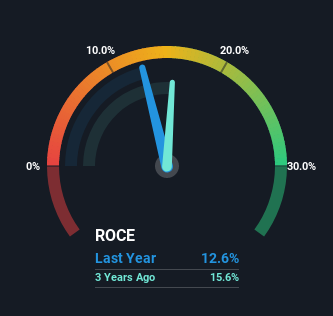Returns On Capital At Pujiang International Group (HKG:2060) Have Hit The Brakes

What are the early trends we should look for to identify a stock that could multiply in value over the long term? Typically, we'll want to notice a trend of growing return on capital employed (ROCE) and alongside that, an expanding base of capital employed. Basically this means that a company has profitable initiatives that it can continue to reinvest in, which is a trait of a compounding machine. With that in mind, the ROCE of Pujiang International Group (HKG:2060) looks decent, right now, so lets see what the trend of returns can tell us.
Return On Capital Employed (ROCE): What Is It?
For those who don't know, ROCE is a measure of a company's yearly pre-tax profit (its return), relative to the capital employed in the business. To calculate this metric for Pujiang International Group, this is the formula:
Return on Capital Employed = Earnings Before Interest and Tax (EBIT) ÷ (Total Assets - Current Liabilities)
0.13 = CN¥319m ÷ (CN¥5.8b - CN¥3.2b) (Based on the trailing twelve months to June 2022).
Thus, Pujiang International Group has an ROCE of 13%. On its own, that's a standard return, however it's much better than the 6.9% generated by the Machinery industry.
View our latest analysis for Pujiang International Group

While the past is not representative of the future, it can be helpful to know how a company has performed historically, which is why we have this chart above. If you'd like to look at how Pujiang International Group has performed in the past in other metrics, you can view this free graph of past earnings, revenue and cash flow.
What The Trend Of ROCE Can Tell Us
While the returns on capital are good, they haven't moved much. The company has consistently earned 13% for the last five years, and the capital employed within the business has risen 129% in that time. Since 13% is a moderate ROCE though, it's good to see a business can continue to reinvest at these decent rates of return. Over long periods of time, returns like these might not be too exciting, but with consistency they can pay off in terms of share price returns.
Another point to note, we noticed the company has increased current liabilities over the last five years. This is intriguing because if current liabilities hadn't increased to 56% of total assets, this reported ROCE would probably be less than13% because total capital employed would be higher.The 13% ROCE could be even lower if current liabilities weren't 56% of total assets, because the the formula would show a larger base of total capital employed. Additionally, this high level of current liabilities isn't ideal because it means the company's suppliers (or short-term creditors) are effectively funding a large portion of the business.
In Conclusion...
The main thing to remember is that Pujiang International Group has proven its ability to continually reinvest at respectable rates of return. Despite these impressive fundamentals, the stock has collapsed 83% over the last three years, so there is likely other factors affecting the company's future prospects. So in light of that'd we think it's worthwhile looking further into this stock to see if there's any areas for concern.
Pujiang International Group does have some risks, we noticed 4 warning signs (and 2 which are a bit unpleasant) we think you should know about.
While Pujiang International Group may not currently earn the highest returns, we've compiled a list of companies that currently earn more than 25% return on equity. Check out this free list here.
New: Manage All Your Stock Portfolios in One Place
We've created the ultimate portfolio companion for stock investors, and it's free.
• Connect an unlimited number of Portfolios and see your total in one currency
• Be alerted to new Warning Signs or Risks via email or mobile
• Track the Fair Value of your stocks
Have feedback on this article? Concerned about the content? Get in touch with us directly. Alternatively, email editorial-team (at) simplywallst.com.
This article by Simply Wall St is general in nature. We provide commentary based on historical data and analyst forecasts only using an unbiased methodology and our articles are not intended to be financial advice. It does not constitute a recommendation to buy or sell any stock, and does not take account of your objectives, or your financial situation. We aim to bring you long-term focused analysis driven by fundamental data. Note that our analysis may not factor in the latest price-sensitive company announcements or qualitative material. Simply Wall St has no position in any stocks mentioned.
About SEHK:2060
Pujiang International Group
An investment holding company, manufactures, sells, and installs bridge cables and prestressed materials in the People’s Republic of China.
Slightly overvalued with imperfect balance sheet.
Market Insights
Community Narratives




